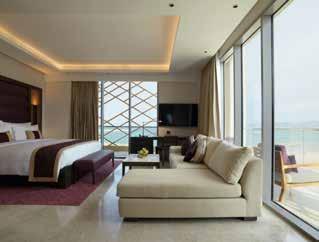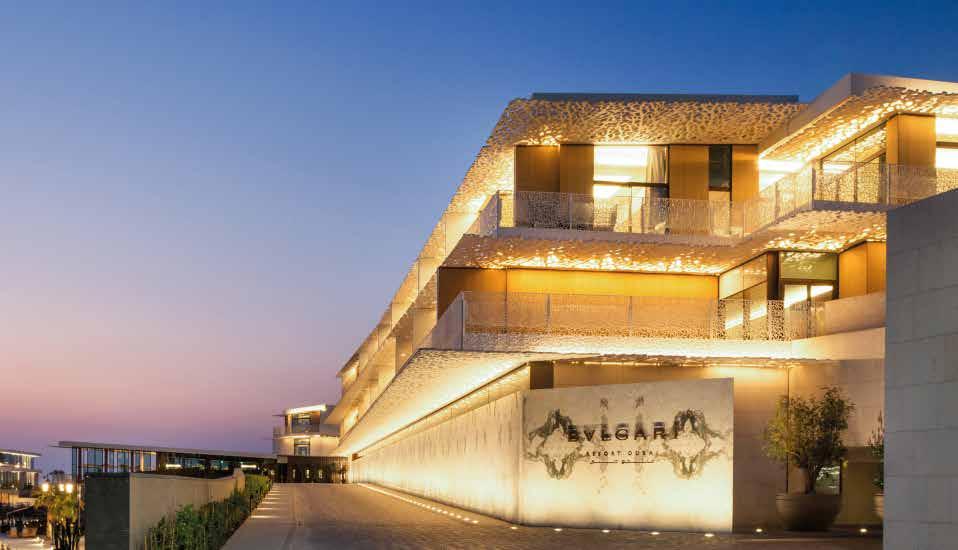
40 minute read
Flanking Sound Transmission between Adjacent Dwelling Units through the Façade
COVER STORY
Façade & Fenestration Industry: Innovations, Challenges & Way Forward
Advertisement
Façade and fenestration industry is a technology-driven industry and innovations keep on happening in this industry. In today’s time, making sustainable buildings is the topmost trend in the construction segment, which is increasing the demand for sustainable and environmentally-friendly façade & fenestration solutions and technologies. Automation is another trend that has revolutionised the façade & fenestration industry. Being one of the largest industries in the Middle East, façade & fenestration industry offers huge opportunities as well as more challenges. The COVID-19 breakdown has brought a tough time for the construction industry, which has a direct effect on the façade & fenestration segment. But, it has also opened a door for innovations to make the buildings hygienic. Automation can play a vital role in achieving the hygienic aspect. In this cover story, we interviewed eminent personalities from the industry and presented their thoughts to know about the important trends, current challenges, and opportunities in the façade and the fenestration industry.
Belarmino Cordero
Technical Director of Façades, AESG
Vivek Chavan
Head of Projects, Sobha Groups (Dubai)
Douglas Sum
Associate (Façade Service Group Leader), Aurecon
International Tower, Abu Dhabi CONTRIBUTION OF FAÇADE & FENESTRATION TO THE ENERGY EFFICIENCY OF BUILDINGS
Belarmino Cordero, Technical Director of Façades, AESG believes, if we focus first on operative energy, the envelope plays a role in controlling the heat exchange between the external and the internal environments.
Ideally, the energy optimisation of a building should start at the beginning of the design process in coordination with the architect. Bioclimatic principles such as optimising building massing (minimum envelope surface for maximum building volume), adjusting the percentage glazing or shading for each orientation has a large potential to reduce energy consumption for less cost but can only be integrated with the design early on.
He adds, from a system design perspective, appropriate performance targets should be specified on the parameters affecting energy transfer through the envelope - solar radiation, thermal resistance, and air infiltration. This shall contribute to minimise the energy required to condition the building. A step further can be taken through systems such as photovoltaics, which can be integrated within the façades or roofs to positively contribute by generating energy.
According to Vivek Chavan, Head of Projects, Sobha Groups (Dubai), there are two ways façade and fenestration can contribute to the energy efficiency of buildings, which are:
1) Climate-based design methods for high-performance façades
Orienting and developing geometry and massing of the building to respond to the solar position
Providing solar shading to control cooling loads and improve thermal comfort
Using natural ventilation to enhance air quality and reduce cooling loads

© Aurecon
Jumeira Al Naseem, UAE
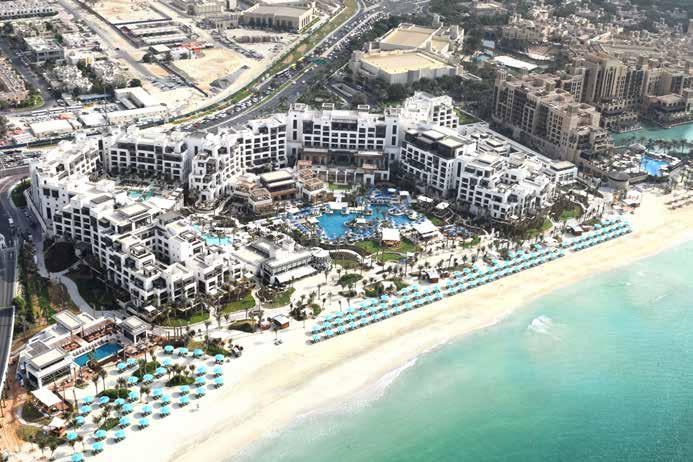
© Aurecon
Minimising energy used for artificial lighting and mechanical cooling and heating by optimising exterior wall insulation and the use of daylighting
2) Climate type design strategies for sustainable façades: Heating-dominated climates, coolingdominated climates & mixed climate
Douglas Sum, Associate (Façade Service Group
Leader), Aurecon notes that energy efficiency has become a very important feature in buildings in today's time. Glass plays a vital role in making the building energy-efficient. Using the right glass for the façade system creates a big difference and achieving the energy efficiency targets of the buildings. The glass allows natural light in the interiors of the building hence reducing the need for artificial lighting.
SUSTAINABLE AND EFFICIENT FAÇADE/ FENESTRATION AND ITS KEY FEATURES
Cordero explains that sustainability is a broad concept and reducing the operational energy of a building is only a part of the whole picture. For a building to be truly sustainable, it is necessary to adopt circular economy fundamentals: The procurement should look at sourcing materials that are abundant or can regenerate. The process for their extraction, manufacture, transportation, and installation should require as little energy as possible. The systems should be designed and maintained for the longest design life possible to extract the maximum value from them and consider decommissioning at the end of the service life to recover and regenerate products and materials.
Chavan says, the façade system delivers the greatest performance to the building owner and occupants when it becomes an essential element of a fully integrated building design. This work examines the growing interest in incorporating advanced glazing elements into a more comprehensive façade and building systems in a manner that increases comfort, productivity, and amenity for occupants reduces operating costs for building owners and contributes to improving the health of the planet by reducing overall energy use and environmental impacts.
Key Parameters of Sustainable and Efficient Façades
Orientation and fenestration: The orientation of a building determines its exposure to sunlight. Since the angle of the earth relative to the sun varies throughout the year and the sun moves across the sky during the day, solar exposure on a façade is continually changing. Strategies for controlling solar heat gain depending on the building’s orientation.
Material selection: Material selection is an important factor in designing sustainable façades. Improving the thermal performance of building envelopes and minimising thermal bridging are extremely important design strategies for sustainable façades. Thermal bridging within a wall occurs where a highly conductive material, such as metal support, penetrates the façade’s insulation layer. Thermal bridging can occur in all types of façades.
Heat and moisture movement: Heat transfer through façades follows a basic principle of physics: heat flows from higher to lower temperatures. This takes place through one or more of the processes that include conduction (heat flows between two façade materials in contact with each other), convection (heat is conveyed by air currents within the façade), radiation (heat flows as electromagnetic energy through materials and air spaces within the façade), air leakage (heat is conveyed by air passing through the façade). Sum opines that when one is designing the façade, the energy model should be taken into consideration to have the most optimum impact on the energy consumption in the building. The second thing that can make the façade sustainable includes using recyclable products and incorporating environmentally friendly products to bring sustainable buildings
ADVANCEMENTS IN THE FAÇADE MATERIALS AND TECHNOLOGIES
The building industry is behind other industries in terms of innovation, but that is precisely why there is now great potential for improvement in Thermal comfort: Thermal comfort is defined as “that condition of mind which expresses satisfaction with the thermal environment”. Since it is a condition of mind, comfort is inherently based on one’s experience and perception; there are large variations in physiological and psychological responses for different individuals. Six primary variables affect thermal comfort are: air temperature, air movement, humidity, mean radiant temperature, occupants’ metabolic rate, and occupants’ clothing. While each of these variables can be separately measured, the human body responds to them holistically. These in turn are significantly influenced by the construction of the glazing units, the material properties of the glass, and the effectiveness of shading elements used with the window.
Daylight: When considering daylight and visual comfort, designers need to consider illumination levels, daylight distribution, and protection against direct sunlight and glare. The integration of building systems is also important, since façades, lighting, shading elements, HVAC systems, and building controls need to function together to have the largest effect on building performance. Translucent glazing materials can be used to provide filtered, uniform, and glare-free daylight. By combining transparent vision glass at eye level with translucent glass above and below, designers can enhance the daylighting while
Vivek Chavan, Head of Projects, Sobha Groups (Dubai)
giving occupants views to the outside. efficiency, sustainability, and quality. Encouraging advancements are being made in the development of new materials, construction processes, and artificial intelligence applications, says Cordero.
Chavan says, buildings are capable of producing up to 33% of carbon emissions, because of which architects are striving towards designing smart façades that are energy efficient. A façade is like a “barrier” between the habitual spaces and the outside environment and most of the energy transfer (heat/cold) takes place through it. Smart façades should be sustainable and its most important criteria are that it should be material and energy-efficient i.e. the façades should consume
or release the least amount of energy to maintain comfort in the interiors. The three design parameters for biomimetic smart façades are air/ wind, shade, and the climate which relates to thermal and visual comfort. Apart from these, an energy-efficient façade should also take into consideration factors like solar radiation, wind speed, and humidity. To help designers inculcate nature into the design, a software known as Bio TRIZ converts data analysis from biology into technology. Using this, architects designed a roofing system inspired by a honeycomb that reduced the heat transfer by allowing longer wave radiations to pass vertically through the open pores of the comb and drastically reducing the surface temperature.
Panel warp analysis
© AESG Chavan adds, solar panels are also an example of biomimicry as they are termed as “artificial leaves” that convert the radiation of the sun for human use and renewable energy, just like the leaves of a tree. Another interesting adaptation of the properties of a “leaf” called the Oxalis oregana, which has the capability of tracking the path of the sun and changing its angle, consequently, has been seen in responsive façades that reduce energy load and can also be applied to existing highly glazed buildings by retrofitting.
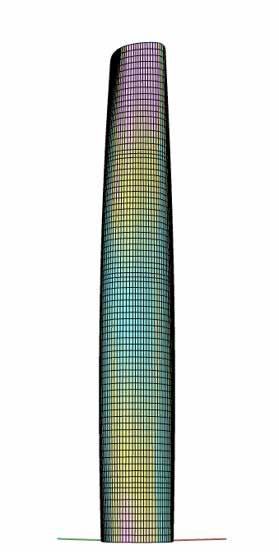
Thermo-bimetals are alloys which contains two separate metals layered on top of each other. Developed by the combination of steel and copper, this product is capable of bending or reshaping itself when exposing to sunlight, ultimately to provide shade without using electricity. The sheet of this thermo-bimetal has many cuts and fenestrations that provide adequate ventilation by capturing the hot air as it rises and releasing it outside. A one-of-a-kind material that can operate on its own to provide shade, light, and air, designed to function in a hot climate, it is an incredibly smart product ready to be explored in all capacities.
According to Sum, designing more energyefficient façade system and window installations in a way that makes the buildings use natural light and provide thermal comfort to the occupants are the major advancements. Another advancement is the addition of dynamic elements, for example the roofs can be programmed to open to get the fresh air inside the building and at the same, the shading can be adjusted automatically.
PREFERRED FAÇADE/FENESTRATION MATERIALS
Cordero believes that it should vary project by project depending on the specific priorities in the brief. The architectural aspirations, energy targets, budget, fire requirements, etc. will weigh in differently on each project. Where possible, the material selection should take advantage of the local resources, manufacturing capabilities, and the lessons learned from local vernacular architecture.
According to Chavan, the preferred materials are glass façades, aluminium composite cladding, solid aluminium sheet cladding, honey-comb cladding, UPVC doors & window system, and ceramic/cota de-esta/ natural stone cladding.
Sum believes that aluminium is the preferred material for fenestration. However, many people
prefer to use PVC, but there are many issues of using PVC. Steel is another preferred material that is widely used as the fenestration material.
ROLE OF SOFTWARE FOR EFFECTIVE FAÇADE/ FENESTRATION DESIGN
Cordero says, CAD tools have traditionally contributed to increase the efficiency, accuracy, and coordination, but BIM and parametric software are now taking efficiency and coordination to new levels.
An interesting application is in the early stages when parametric tools allow analysis to be run on numerous configurations and provide the design team with immediate feedback.
Parametric software can also be used to rationalise free-form geometry. An example can be found in Ciel Tower in Dubai Marina, a 360m high tower by Norr with a glazed curved façade. While fabricating curved glass panels were possible, it is quite expensive. To reduce cost, the panels were designed to be fabricated flat and then cold-bent to shape. Certain rules had to be set responding to engineering principles. There is, for example, a maximum curvature that can be achieved without inducing excessive stress on the glass and the structural silicone. This and other structural or manufacturing constraints were embedded within a script that analysed the geometry. Where the allowable curvature was exceeded, the design had to be adjusted in an iterative process. With traditional tools, this process would have been very labour intensive. The benefit of doing this parametrically is that once the script was generated, subsequent geometry adjustments or options could be explored with minimal additional work.
Chavan opines that the most interesting feature in the software is the CAD interface. The most prominent fenestration software comes with an internal CAD interface which is simple and userfriendly. An easy to understand the arrangement of all relevant functions provides you with a ready to use the CAD output. For structural design analysis, the STAAD-PRO software is mostly used.
He adds, “to begin with, let’s talk about software which specifically focuses on designing and fabrication of doors, windows, and façades; here the profile and the hardware database play a key role. Then we have ‘Enterprise Resource Planning software’ (also known as ERP systems) which can manage an array of your entire business. ERP systems bring all business processes and data on one platform. There is INTRANET, SAP also is in use for operations”.
COMFEN, an early-design energy modelling tool, is designed specifically to make informed decisions about building fundamentals by considering the design of the building envelope, orientation, and massing on building performance. It supports exploratory work early in the process by architects, but is also useful for engineers and consultants later in the design process.
Shangrila Hotel Tower, at HH Sheikh Zayed Rd, Dubai
© Vivek Chavan
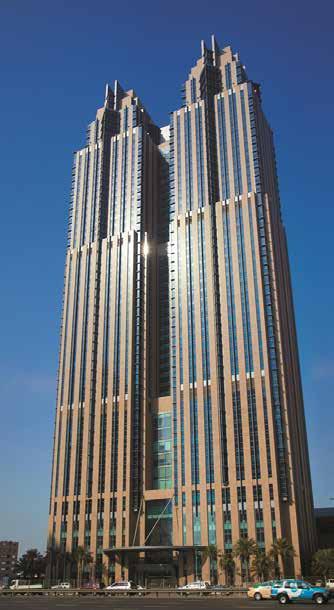
© Vivek Chavan
Sum states that the software plays a very important role in designing effective fenestration design. Different software can be used in each step of the construction process, from modelling, façade designing, creating the 3D structure of the building, and installing the fenestration materials. He believes software connects every process of the building construction from engineering to designing, to fabrication.
PERFORMANCE PARAMETERS THE FAÇADE & FENESTRATION NEEDS TO ADDRESS
According to Cordero, the building envelope needs to address a long list of performance parameters that include energy and sustainability, health and comfort, safety, durability, etc. It has to do so while protecting the architectural intent, ensuring that the design is feasible and can be procured on time, in the budget, and to the required quality.
Chavan suggests the following parameters:
Enhanced sun protection and cooling load control while improving thermal comfort and providing most of the light needed with daylighting
Enhanced air quality and reduced cooling
Dubai Mall

loads using natural ventilation schemes employing the façade as an active air control element
Reduced operating costs by minimising lighting, cooling, and heating energy use by optimising the daylighting-thermal trade-offs
Improved indoor environments, leading to enhanced occupant health, comfort, and performance
High-performance with building aesthetics/ architecture
High-performance with sound insulations
Fire resistance as per the requirement of fire ratings
To maintain pressure equalisation
Water & air permeability tested as per specified standards
He adds façade system solutions must respect the constraints of latitude, location, solar orientation,
acoustics, earthquake and fire safety, etc. Since climate and occupant needs are dynamic variables, in a high performance building the façade solution must have the capacity to respond and adapt to these variable exterior conditions and to changing occupant needs.
According to Sum, the façade should be sustainable and environmentally friendly. It should be strong and should have good air and water tightness. It has to provide good acoustic and thermal insulation. These all are factors that make the building cost-effective and it is one of the most important features of a highperformance fenestration.
COVID-19 EFFECT ON FAÇADE & FENESTRATION
With construction being considered a vital sector, many sites have been allowed to remain open observing strict safety measures. This has kept consultants and contractors busy despite the challenging months. “We have managed to maintain a healthy pipeline of work by leveraging our diversification across multiple markets, covering Europe, the Middle East, and Asia. Improved remote working capabilities have allowed us to effectively pool our resources to successfully deliver on international projects”, says Cordero.
Chavan believes that the façade industry also impacted the same as the real estate industry. There are both aspects of the crisis as well as opportunities. Due to the impact of COVID-19, the industry may find shortages of liquidity, materials, and labour, etc. many upcoming new projects will be getting halted under recession. The cost of products, materials & labour will be increased. Demand for high performing façades may be decreased in the short term due to cost constraints.
The glass separations/façades & fenestrations into the offices/buildings will be increased in futuristic design. High demand will be expected for fenestrations due to existing project completions delayed/impacted as façade delivery is almost at completion.
The industry is facing a tough time due to this pandemic. The logistics across the country are seriously affected and the labours started going back to their respective countries. The flow of funds has been hampered and the confidence of clients is going down.
HOW TO DEAL WITH THE AFTER-EFFECTS OF COVID-19?
The building industry has adopted safety protocols to reduce human interaction and minimise transmission risk through manufacturing, transportation, and installation. This has been, however, a short-term emergency response. In the longer term, a further push for automation can be expected, says Cordero.
On the design side, practices have been successful at shifting face to face communication to video-conferencing with minimal disruption. The pandemic has acted as a catalyst to implement this already available technology and has revealed its potential to reduce transport and
© Aurecon
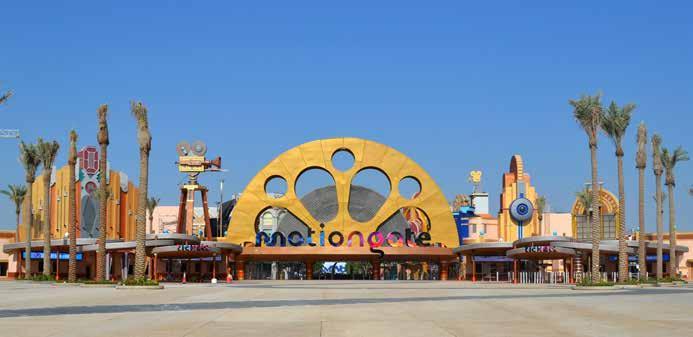
Motiongate theme park, UAE
its associated costs, time, energy, and emissions. It has also enhanced collaboration across geographies.
He suggests, to thrive, design practices need to systematically re-evaluate their offering and work more efficiently. We need to step up qualitatively to add more value to our Clients. It is time to be creative and innovative. Automation through the parametric software will play an important role in increasing efficiency.
Chavan advises using all HSE parameters and protocols, to preserve the resources for expected high demand after the open up projects, to hedge low-cost materials on drop-down prices, to take liquidity help from banks for sustaining and better utilisation, and to develop the facility as per product demand on post effect of the pandemic.
Sum thinks that the conventional way has been paused and there is a need to think of an effective way of delivery of the projects. There is a need to adopt design automation and robotics installation which is a way to move forward to sustain this industry. Another important thing is that the design of the building is supposed to be flexible enough to adapt to the rapidly changing environment.
ADVANCEMENTS IN AUTOMATION IN FAÇADES AND FENESTRATION
According to Chavan, façades fabrication facilities are progressing with automated robotics machineries. Earlier manpower utilisations are more in most of the areas from cutting, notching, slitting, cleating, punching, assemblies to glazing. Robotic stainless steel welding is very seamless and productive. It will reduce the labour cost in highly demanding and high-quality Middle East markets. Robotic welding and metal fabrication involve highly complex and sophisticated technology. Generally, nowadays working on
Facade options study
© AESG

automated CNC machineries, it is also getting effective productivity & desired quality.
Sum opines that the design can be automated by writing programs and scripts. We are also writing the scripts to generate the designs, especially the connecting fabricator joints when you have the model ready. All the fabrication data can be generated by pressing one button. The CNC machines by now can be automated and the fabrication data can be automatically inputted in them. The robotics are in trend to make the fabrication process easy.
WAY FORWARD FOR THE FAÇADE & FENESTRATION INDUSTRY IN THE MIDDLE EAST
The new needs and the ability of technology to address them shall drive change in the industry. Cordero says “in my view, the main drivers of change revolve around the need to take action
St. Regis Saadiyat Island Resort, UAE
against climate change (energy and sustainability), improve the health and safety of the occupants and users of public spaces (particularly fire safety and comfort) and reduce costs”.
Chavan notes that the real estate developers & façade consultants/engineers need to take interests and extend supporting hands for the façade & fenestration industry in the Middle East. Façades are higher cost materials, therefore banks/developers need to support with liquidity/ cash flow, to undertake direct interest and deploy industry experts for proper delivery, to overcome with reasonable/workable design solutions.
He also suggests that the contractors/ subcontractors secure their resources along with banking & client support. They need to study & enhance their products as per current market requirements and secure supply chains for the way forward.

Innovation in Façades: Sustainability in Focus
Introduction
Over the last years, sustainability became a ‘household’ term in almost every business sector that we somehow grew tired just hearing about it. Mainly because Return-on-Investment-driven markets like most in the Middle East, used this more of a marketing tool than what is supposed to be its real essence. Combined with the commercial pressure on the market happening already before the Covid-19 pandemic, we could hardly feel its genuine implementation at all.
Sustainability happens earlier than even choosing a façade material or a design. When you read the comprehensive meaning of sustainability, you may even be surprised at the areas it is covering and how they are connected to each other.
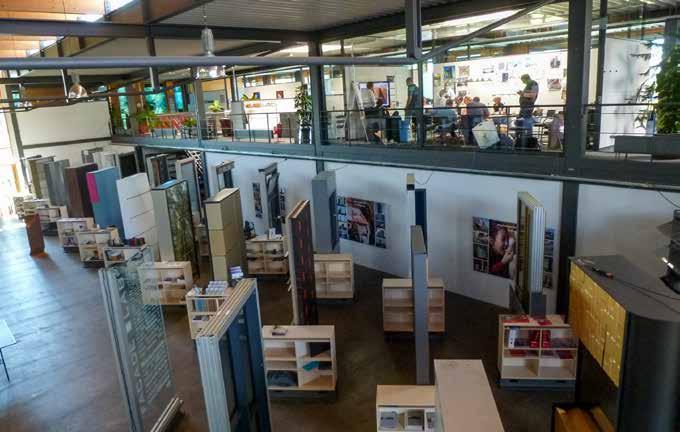
Micha Pawelka Managing Director, Priedemann FZCO
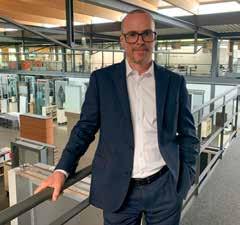
A sustainable design developed by a company out of a sustainable corporate culture, is like a farmer who plows and fertilizes his land to ensure years of fruitful harvesting. He doesn’t focus on a short-term single profitability but he invests in the preparation and maintenance of his land to ensure a long-term productivity. This sustainability culture goes well deeper than the superficial marketing stunts to benefit not only the company’s shareholders but also the employees on a long-term perspective. A sustainable company treats each of its employee like a family
Priedemann Facade Lab showroom
member and not merely just an ID number. They prefer to grow leaders within the company rather than hiring external individuals who may not have the same ethical compass like theirs.
All these aspects help us understand sustainability from a wider perspective, subsequently impacting the operational chain of any company.
Role of Façade & Fenestration in Making EnergyEfficient Buildings
The façade serves as the enclosure or ‘skin’ of the building. Compared to a solid wall, the façade is ONE transparent part that shields the habitats from environmental nuisances. The performance of the façade or the window is important, but the interface with the solid parts is of the same significance. While a façade or a window might be a good performing unit, it becomes almost useless if it is not assembled properly. Similarly, a well-executed interface does not improve the performance if the installed materials have poor quality.
Together with the HVAC system, the façade forms the most important building part with regards to energy-efficiency. From an investment point of view, the façade is one of the most important building elements that give the building also a face, a Design.
Sustainable and Efficient Façade/Fenestration
First of all, the question is how sustainable a façade can be if the building in which it shall be installed is not sustainable. The sustainability starts with the view on the building's lifestyle. Construction always utilises resources. It uses and wastes resources at the same time, and therefore a construction should be driven by the conservation of resources. It starts with the planning of the building, the plot itself, the construction, the usage, and the dismantling and recycling of the used materials. Architects adopting this focus on a material’s embodied carbon footprint, indicate sustainability since it covers not only the manufacturing of material but its use, subsequently, its recyclability.
So, to design sustainable façades, we have to look at the environmental impact of the used materials and their expected lifecycle from manufacturing to recycling until it is re-used. In general: using less, but better materials, recycled material and ensuring recyclability after use, sourcing locally, and ensuring low maintenance requirements.
Fully glazed façade of Festo AutomationCenter
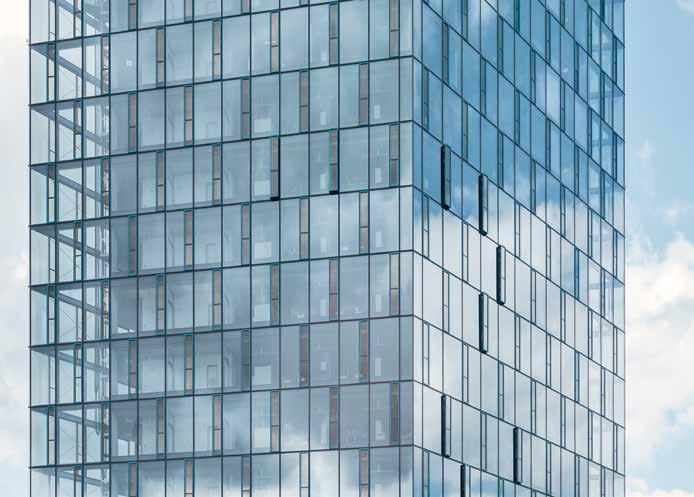
© Festo AG
Fully parametric 3D-detailing and complex 3D-printed profile geometry

Clients have to be aware that this approach has an impact on the cost of a façade or a window. And this impact can only be considered as a saving when we regard the lifecycle of the unit, and not only looking at the short-term purchase price.
Advancements in the Façade Materials and Technologies
Glass applications have made a big step forward. We have better coatings available with higher selectivity, materials are coated and manufactured locally. Light-weight materials, such as GRCs, are becoming more available and are no longer a special solution.
We now also see more options for adaptable glass coatings, like electrochromic glass. The photovoltaic (PV) technology is improving and soon we may see transparent PV cells where the architect is not limited anymore.
However, the biggest development for us is the adaptable façades that react to the environment independently. Priedemann is at the forefront of these developments with our ACT façade, a kind of a double-skin façade on-demand and ARKOL, a solar-thermal venetian blind system with embedded photovoltaic. While nowadays façades are still shielding and reflecting energy into the sky - the future façade will collect and use the energy as active skin.
The technology is generally developing towards the digital embedment of the façade. Future façades will collect data to improve usability and adaptability. And who knows? In the same way, in which you can return your fridge or your car to the manufacturer for recycling at the end of its lifecycle, you may also return your façade and ‘exchange’ it with one that meets the latest technical performance envelope. In the future, we may be able to rent or lease a façade, instead of buying it, including full maintenance.
Preferable Façade/Fenestration Materials?
This is probably not easy to answer, but I want to touch one aspect here: The most used façade material is aluminium and there is a continued discussion on the sustainability of aluminium since it is very resource-intensive when manufactured. However, this resource intensiveness can be minimised by up to 95% when aluminium is recycled. This is a huge potential with regards to recyclability but requires careful consideration in the design and specification.
Effective Façade/Fenestration Designs: Role of Software
Software plays an important role in every stage. We need software and there are many options used in the market. The software can do everything but we see it as more important to understand and use the communication between and the adaptability of different software rather than focus on one specific software. For example, Revit is used more as a communication tool than design software. Similarly with BIM, there are many requirements and requests in the market and on projects; but we, and our clients as well, realise the limits when it comes to façade design. We are expecting a changing landscape of façade engineering with regards to
the digital disruption. Digitalisation and parametric design are not new for us. We have been doing it for more than 10 years. In our experience, BIM is just one of the many tools, but our approach is more comprehensive.
Our research focus is on “Intelligent Façade Engineering” (IFE), which is a virtual, integrated procedure for optimised designing, accomplishing, and management of façade constructions in accordance with the method of BIM. To do that, all relevant information is put into a digital database and linked up as a virtual component orientated 3D façade model. The primary function of the parametric volume model is to generate data for detailed design and construction documentation, for order lists and lists of material integrating with controlling CNC manufacturing automates. But even this will not be the end, we collaborate with partners on working on the next steps for the industry. We invest in software, space, and most importantly in human capital to tackle these important tasks.
Indicators of High-Performance Façade/ Fenestration
Some believe it is the U-value, hence, we have challenges explaining to our clients that conditioning the air inside your building is much costlier than investing in intelligent and smart solutions for an active shading solution or, even better, in a smart skin to generate power.

Lunch breaks during Covid19 times
In the past, we had the U-value Olympics in Germany: The lower the better, triple-glass, vacuum glass. This shall change to factors like embedded carbon footprint, recyclability, and the integration of adaptable façade solutions. We look forward to a new Olympics, where buildings are competing with each other on which is generating more power.
Effect of COVID-19 on Façade & Fenestration Industry
When it comes to humanity, there is no difference, be it the façade & fenestration industry or any other industry. Our priority is for our family members to be healthy and safe, both the personal family and the Priedemann family. And so far, we are blessed with regard to health. We were reacting quite early and we were able to protect our teams accordingly.
Compared to other industries, we might be luckier for the construction industry is usually a big driver of the economy. Most running projects usually continue, which is our global experience during the pandemic. That is why we are currently in a challenging but stable position. We are even hiring at the moment.
Suggestions to Deal with the After-Effects of COVID-19 Pandemic
Well, it is hard not to limit the outlook to the financial topic because that is where we were mostly affected by directly. Besides this, we probably all learned that health and safety are much more relevant than short-term financial benefits. It might be the reason to have a more sustainable look into our investments into buildings.
We also expect some impact on the design itself. Office spaces or entrance solutions might change. Natural ventilation is much more important than we ever expected and contactless interaction and handling within a building might be more important.
Last but not the least, we all have learned suddenly that we do not need to jump immediately in an aircraft to attend a meeting. There are many smarter solutions that we realise only during challenging situations at times.
Major Challenges in Façade/Fenestration Design and Applications
Well, the first challenge is to adapt to the postCOVID-19 situation and this may require some creativity and unconventional solutions.
Then, we have to design more sustainably: Select solutions that need fewer resources, less energy and make more out of less.

Thirdly, I want to mention the huge work and potential which is waiting on existing buildings. There is a massive energy wastage problem with current buildings and with ACT façade, we can have solutions in place to upgrade and enhance installed façades rather than wasting them, which would not be sustainable at all.
Advancements in Automation in Façades and Fenestration
Since we are designing towards an active façade skin, an adaptable façade, or adaptable materials, the advancement will be façade integrated sensors. They are going to collect user data, and with machine, learning capability to adapt to the users’ needs and requirements using analytic algorithms. The system will learn and it will enhance usability and comfort.
We can already see this trend in accessory applications, giving a glance at what is waiting for us.
Future of Façade & Fenestration Industry in the Middle East
We are known for our efforts to continuously share our knowledge with our clients and the façade community in the history of façade consultancythe root of this discipline and the reason it evolved. And this was always a matter of quality: Quality of design, the quality of manufacturing, and the installation. And we believe this has become valid and important in a crisis, more than ever. In some
© DAW SE
The demo-façade with solar thermal strip collector
countries, buildings, residential towers, became almost a short-lived commodity where long term qualities do not matter. This development does not fit the importance of the façade discipline and it will have an impact on the quality and hence on the sustainability of a building.
Therefore, we believe quality will prevail. What will be designed and what will be built, will focus more on quality and sustainability. In a time where investments are a challenge, owners will have to look on a long-term Return-on-Investment, hence on the lifecycle.
Of course, the pandemic changed almost everything in the market, even national strategically government plans slowed down and changed, and it will take some time until we can see if and how they recover. A crisis also discloses the fitness of a company and we saw Multinational companies stumbling and almost falling within weeks of the lockdown. This might also be applicable to our industry and the survivor will focus on better quality business.
We all realised that we need to consume much less than we were used to. We learned to appreciate what we have and save and protect the existing. We expect and are prepared that the same will happen with regards to existing buildings. Smart engineering solutions will be required to retrofit and upgrade existing buildings and façades for another façade lifecycle and Priedemann is ready for such demand.
DEWA Headquarter, Dubai - World's Largest Zero Energy Building
DEWA headquarter, Dubai
This project is going to be the world’s largest zero energy building equipped with compact solar panels covering an area of 20,000 square metres. It will produce more than 6600 MWh per year of renewable energy. This means the building will generate its entire required power on-site with no grid connection. The photovoltaic solar panels are placed on the roof and integrated into the façade.
thermal venetian blind
ArKol (2016-2020) - a German research and development project, was meant to create two innovative façade collectors that will give engineers the freedom to design solar architecture: On one hand, the solar strip collector gives a high solar thermal performance while the material and the distance between the strips can be picked from a wide range. On the other hand, solar thermal venetian blinds were developed. They are appropriate within the double skin façades, they can draw in and tilt as the conventional venetian blinds,
Quick Facts:
Client: Dubai Electricity and Water Authority Architect: Obermeyer Middle East Technical features: Unitised system, BIPV solar panels, GFRC/GFRP fins and Mashrabiya Scope: Façade and BMU consultancy, concept design, schematic, working and final drawings, performance specification Status: Under construction
It is geared to achieve a platinum rating from LEED, as it also intends to have a state-of-the-art building management and control system that will shut down unnecessary usage of lighting, cooling, and water
ArKol and DESTINI, Germany – R&D Project
The façade unit with solar

© Fraunhofer ISE
supply automatically.
Quick Facts:
Partners: Priedemann Facade-Lab, Fraunhofer ISE, DAW SE Technical data: Building integrated solarthermal systems (BIST) Status: R&D in progress, TRL 5/6 Scope of work: Research & Development
harvest thermal energy and can reduce the solar heat gain coefficient (g value). Both two innovative technologies use heat pipes to gather the heat effectively.
The subsequent project "DESTINI" proceeds with the development of solar thermal venetian blinds, aiming to demonstrate the system in an operating façade within the building project SpringPark VALLEY. In this, the performance can be assessed with a detailed performance monitoring. The venture began in May 2020 with accomplices from research and the construction industry.
FACE TO FACE
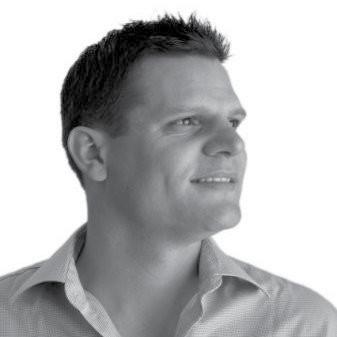
Jeroen Kortekaas
Head of Architecture, Bluehaus Group
About the Author:
Jeroen Kortekaas is the Head of Architecture at Bluehaus Group. In his career, he has been involved in every phase of the design process, from concept design to construction documentation, for both small and large-scale projects. He completed his Masters in Architecture in 2004 from Delft University of Technology and has been chalking up extensive international experience since then. Apart from working in the Netherlands, Jeroen has also lived and worked in China and the Middle East. He has built up an impressive portfolio covering educational, residential, large-scale, and mixed-use projects. Now, he is also developing hospitality and high-rise projects. Here are the excerpts from his recent interview with Window & Façade Magazine…
What inspired you to become an architect? How is your journey so far since you started your career?
In junior and secondary school I always liked to draw and physics and mathematics came quite easy to me. Architecture seemed to be a natural choice as it can be considered both art and craft, design, and engineering. Since my graduation from the Delft University of Technology in 2004, I have lived and worked in The Netherlands, Shanghai China, and Dubai in the UAE. I have worked on all scales in a variety of sectors, building up a portfolio covering residential, retail, large-scale mixed-use, as well as expertise in hospitality and high rise projects. Currently, I hold a senior leadership position, Head of the Architecture business unit, within Bluehaus Group and I enjoy leading a multi-disciplinary team to create the best possible design and continue to use my creativity for viewing architecture from different angles. I like being on the forefront of developing innovative design strategies and strive to bring a conceptual approach to every project.
Al Rajhi Headquarter, Riyadh

© Ales Photography FZ LLC
Could you please tell us about some of your major projects?
I have been lucky to have worked on numerous prestigious projects in various countries. Most notably the Raffles Hotel in Jeddah comprising of two individual towers, a 240-meter tall residential tower, and a 140-meter high hotel tower along the Corniche Road with a cantilevering ballroom. Before this, I delivered the tower component of the Al Rajhi Headquarter in Riyadh, a 240-meter tall office tower with unique twisting cores placed on the outside of the tower (concept Design by SOM). Furthermore, I worked on the Mica Mall on Kish Island in Iran. This mall features 300,000 Sq m of leasable area with a vast array of entertainment features such as an aquarium, indoor skydiving, and a cable car track. Also, I designed a 3,000 key hotel called the Conghua Resort Hotel in Conghua, China. And last but not least I worked within a team on the highly acclaimed TWM Kempinski Hotel in Muscat, Oman. This hotel has the most amazing lobby to be found in the hospitality sector.
Currently, I am working on three incubator offices in Sharjah for the Sharjah Government, several high-end residential villas, and a yacht club building in Dubai and Bluehaus is coping well with the challenges in the current climate.
Bluehaus Group has completed over 2 decades in the Middle East. How has its journey so far?
For the first 10 years since the inauguration, Bluehaus grew as an interior design consultant focused on Workplace strategy and design. The key milestones for that decade were simple, but memorable achievements such as headcount reaching 10, then 20; and moving to larger offices from Bank Street to Gold & Diamond Pack and then TECOM; coupled with more propelling achievements such as attaining our first multinational workplace client, our first multiple repeat customer and our first regional framework with a multi-national. Our second decade of operation has delivered greater challenges, presented more risk, and seen tremendous reward as Bluehaus diversified its service offering to include architecture and MEP engineering design; diversified its vertical target markets to include hospitality, F&B, leisure & entertainment, public spaces; residential and retail design. Further, geographical market penetration and an investment in technology that has secured our continued focus on innovation. And here we are today!
What future opportunities and trends do you see in the architectural segment in the Middle East?
There will be a plethora of opportunities related to digital innovation such as 3D printing, digital fabrication, and the evolution of sophisticated software packages. 3D printing will start to scale up which will allow larger building components to be printed, or even complete structures. The digital fabrication of building elements, driven by new powerful software could lead to greater customisation at a cost-efficient price point. This in turn shall lead to more unique structures and building envelopes.
Furthermore, I think there will be a greater need for energy-efficient buildings. For example, and although not often used in the Middle East, crosslaminated timber seems to be a new structural solution to achieve more sustainable buildings as well as triple glazed window assemblies.
According to you, where is the architectural segment is heading in the Middle East?
There seems to be an ongoing trend currently to design and build contracts driven by great pressure on budgets and completion dates to mixed results. However, contractors are quickly adapting to this new way of procurement and at Bluehaus, we have noticed an increase in partnerships with contractors.
Locally, now Expo 2020 has been delayed by a year, the necessity to complete projects before the commencement of this event has been removed. This has caused clients and developers to re-assess their current portfolios and future developments and in several instances provided some welcomed breathing space. In some cases, projects have been brought forward, namely refurbishments, to leverage from the window provided by having Expo a year later. For the wider region, Saudi Arabia remains a key market
Kempinski Hotel, Muscat, Oman

with several large scale developments continue to gather pace and we are also excited by the energy being seen in Abu Dhabi.
Could you please tell us about the latest façade and cladding technologies and materials available in the UAE market and those you used in your project?
In general, the construction industry is very slow to adopt new technologies. However, recently in the United Arab Emirates, the biggest catalyst for a change of façades and façade technologies revolved around certain aspects of the fire life safety of buildings such as improvements to the fire-resistance rating of materials and assemblies, the introduction of fire cavity barriers and the omission of bituminous layers within the wall built-up.
Inevitably sustainability will play a far greater role in the future. There are already huge improvements observed for high-performance glass which reduce solar transmission whilst limiting the reflectance of the glass. New fabrication methods allow double curved glass and double-curved façade panels. Most likely, it is not about introducing new materials to the market as such, but stretching the properties of existing materials to allow for new uses within the building envelope. For example, I am experiencing an increase in insulation layer thicknesses to improve the thermal properties of the façade.
That being said, the appetite for using new materials and technologies by clients and developers within the current market conditions remains somewhat subdued. Building materials require a proven track record within the climatic conditions of this region before these materials will be truly taken into consideration.
Kempinksi Hotel’s ballroom
© Woods Bagot
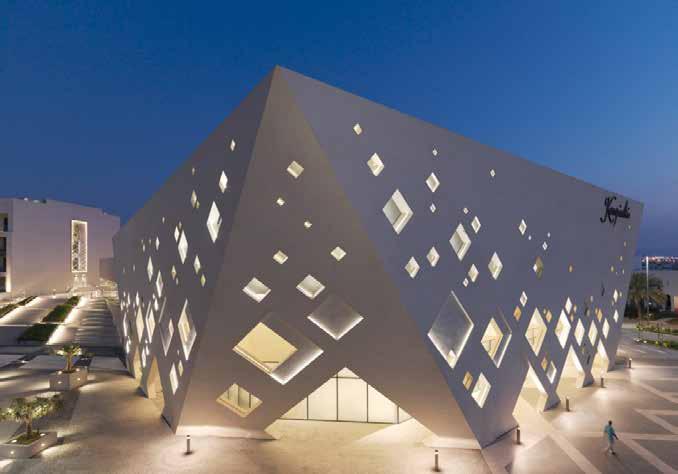
Could you please brief on the technological benefits of the well-managed façades?
Well-managed façades not only relate to the maintenance of the façades during the operation of a building but should take be taking into account at the commencement of the design. You should spend enough time during the design stage to fully develop the building envelope, improve constructability, allow for testing and commissioning which should result in more efficient construction, and reduce building operating costs.
What are your views on the future façade and fenestration technologies as well as materials?
The key here is environmental concerns, using recycled and recyclable materials that should contribute to achieving higher sustainability targets. The ultimate goal is to realise selfsustainable buildings. In the future, I can see photovoltaic panels being completely incorporated within the façade and kinetics façades being the norm. These changing façades are responding to the change in climate conditions per day or per season, continuously adapting to provide the optimum performance of the façade.
What are the challenges the architectural segment is facing due to this Covid-19 situation?
Across the board, many sectors and disciplines, have been enormously impacted by Covid-19. Probably the biggest constraint on the business environment is the limitation of liquidity and cashflow, which is trickling down through the market. This brings a raft of other challenges to the table such as a few upcoming projects, hard-fought acquisitions with reduced margins, and delayed payments of invoices. However, having navigated two previous economic crises, Bluehaus has acted swiftly and with great care, at this moment we remain cautiously positive about the construction segment.
Kempinski Hotel’s lobby/entrance
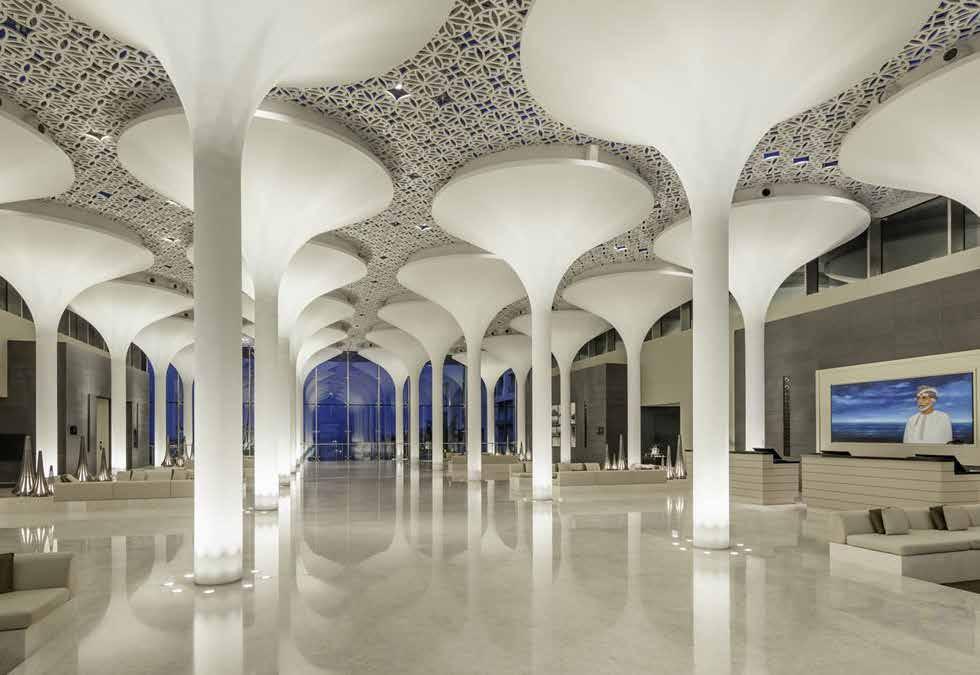
© Woods Bagot
Has this pandemic affected your business? How are you dealing with this situation?
Of course, everybody has been working from home, most likely without facing too many problems. At Bluehaus, we like to learn from this unprecedented event, and going forward, we are implementing a ‘4+1 work week’. This means our team members have the choice of working Thursdays in the office, or from home – or in some cases, they may choose to work a Thursday in the office due to deliverables or and another Thursday from home as they need to focus. It is proven by Gallup that this balanced and flexible way of working results in higher levels of staff engagement.
The Covid-19 situation has taught us that the world is changing, moving away from doing some things the old way, and forced us to adapt and bring new policies, procedures, and working methods into our office for this new era. We are excited about this.
As a well-known architect, what sustainability means to you and how do you ensure the sustainability aspects of your projects?
If the client or developer is the end-user of the building, the targets and ambitions related to sustainability are often quite easily met. There is a common interest between all parties and stakeholders. Once this scenario changes into a developer partnering up with an operator, resulting in a third party being the end-user, problems start to occur. There is suddenly a discrepancy between the party increasing their capital outlay for more efficient and often more costly solutions or equipment and the third party enjoying the savings made by this increase in costs for the said solution or equipment. This can only be solved by
Kempinski Hotel’s grand deluxe sea view room
the intervention of the Authorities by imposing stricter regulations towards sustainability. It is to note that great advancement has already been made such as the Estidama sustainability scheme and the net-metering of PV panels feeding unused electrical power back into the grid.
Every architect should keep in mind that construction has an enormous impact on the environment, including transport of construction materials, disruption to nature, and the long term energy consumption. In my opinion, the greatest opportunity for the construction industry is to re-use and renovate existing building stock as opposed to demolish and re-build. If we collectively double the lifespan of buildings, we are twice as sustainable.
What is your advice for young and upcoming architects?
Persevere and try to gain some valuable experience early on and leverage from that to find that niche you can thrive in.
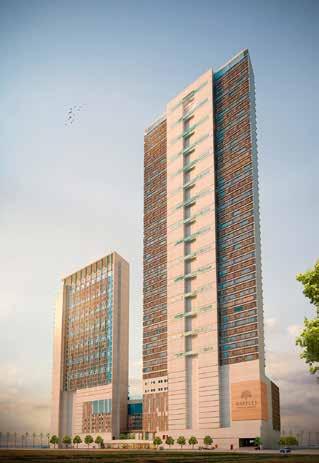
Aqua Raffles, Jeddah, Saudi Arabia
© Woods Bagot
